A Preliminary Study Was Conducted on the Compressive Strength and Flow Performance of Environmentally Friendly UHPC-SCA
Abstract
:1. Introduction
2. Experimental Preparation
2.1. Experimental Materials
2.1.1. Coarse Aggregate
2.1.2. Fine Aggregate
2.1.3. Mixing Water
2.1.4. Cement
2.1.5. Mineral Admixture
2.1.6. Water-Reducing Agent
2.1.7. Fiber [24]
2.1.8. Detailed Information of Test Materials
2.2. Detection Instrument
- A hammer crusher from Pioneer Instrument Co., Ltd. (Dalian, China) can screen aggregates with a particle size range of 150 mm to 10 mm.
- A vibrating screen machine manufactured by Shanghai Xing Building Materials Test Equipment Co., Ltd. (Shanghai, China) with a shaking frequency of up to 221 times/minute and a motor power of 0.37 kW.
- A constant temperature drying oven from Shanghai Luda Experimental Instrument Co., Ltd. with a size of 500 × 600 × 750 mm and a room temperature range of 10 °C to 300 °C.
- An electronic scale manufactured by Shuang Jie Test Instrument Factory, Changshu, with a maximum range of 100 kg and an accuracy of 10 g.
- A concrete mixer from the same manufacturer as the vibrating screen machine with a predetermined mixing capacity of 60 kg, a shaft speed of 47 rpm, and a rated power of 2.2 kW.
- A vibrating table made by the same batch of Roots mixers with an overall size of 1000 mm × 1000 mm, a vibration frequency of 2860 times/min, and a maximum load-bearing capacity of 200 kg.
- A curing box produced by Shanghai Luda Experimental Instrument and Equipment Co., Ltd. with a controlled temperature of 20 ± 1 °C, relative humidity of ≥90%, a heating power of 800 w, and a cooling capacity of 145 w.
- A TYE-2000E pressure testing machine produced by Wuxi Jianyi Instrument Machinery Co., Ltd. (Wuxi, China), with a maximum pressure of 2000 kN.
2.3. Setting of Mixing Ratio
3. Testing Process
3.1. Compression Strength Test
3.2. Detection Process
- Collect the necessary materials, including shells, sea sand, and seawater test materials.
- Clean the shells and remove impurities from the sea sand. Using a vibrating screen, separate sand particles with a size of 0.15–4.75 mm. Seawater can be used without treatment.
- Place an appropriate amount of fine aggregate, cement, and mineral powder into a dryer to dry.
- Weigh the processed materials in proportion for later use.
- Coat the inner surface of a 100 × 100 × 100 mm trihedral die with a release agent.
- Mix the coarse and fine aggregates in a blender for 1 min. Add cement and stir for 1 min.
- Mix the water reducer in the mixing water, then slowly pour 2/3 of the solution while stirring and add the remaining 1/3.
- Sprinkle fibers into the concrete within 5 min.
- Pour the concrete into a tray and conduct slump and expansion tests.
- Fill the die twice, compacting the first half with iron bars, and repeat on the second half.
- Vibrate the concrete on a vibrating table for 30 s to remove bubbles and excess concrete.
- Scrape the surface of the test block with a scraper and control excess parts within 1 mm of the die.
- Mark the specimen and affix a plastic film to prevent water loss.
- After 48 h, de-mold the block and cure it in a standard curing box at a temperature of 70 ± 2 °C and humidity of not less than 95%.
- On the 3rd, 7th, and 28th day, remove the block, dry the surface, and test its compressive strength with an instrument. Record the data.
4. Analysis and Discussion of Data
4.1. Flow Properties of UHPC-SCA
4.1.1. Measurement Steps
- (1)
- Firstly, thoroughly wet the slump cone, funnel, and measuring tool. Then, place the funnel above the slump cone;
- (2)
- Put the cement mortar into the slump cone three times equally and tamp it with a vibrating rod 20 times after each loading. This ensures the uniform distribution of the cannon on the cross-section. Clean up the excess concrete after loading and finally smooth the top surface;
- (3)
- Lift the cylinder vertically and smoothly, measure its slump and expansion after 60 s, and control the entire process within 3 min.
4.1.2. Data Analysis
4.2. Analysis of Compressive Strength
4.2.1. An Analysis of the Adaptability of Crushed Granite Stone
4.2.2. UHPC-CA Analysis of Oyster Shells
4.2.3. The UHPC-SCA Analyzed Cone Shells
4.3. Discussion on Marine UHPC-SCA Test
5. Conclusions
Author Contributions
Funding
Data Availability Statement
Conflicts of Interest
References
- Abdal, S.; Mansour, W.; Agwa, I.; Nasr, M.; Abadel, A.; Onuralp Özkılıç, Y.; Akeed, M.H. Development status and engineering application of ultra-high performance concrete. Guangdong Civ. Archit. 2022, 29, 90–92. [Google Scholar]
- Huang, Z.; Shen, P. Experimental study on 200MPa ultra-high strength steel fiber concrete. Concrete 1993, 3, 5. [Google Scholar]
- Chen, F.; Xu, F.; Zhang, G.; Ding, S.; Ming, Y. Study on fundamental properties of ultra-high performance concrete with coarse aggregate. In Proceedings of the 2018 National Academic Annual Meeting of Industrial Architecture, Beijing, China, 8 April 2018. [Google Scholar]
- Long, K.; Sun, J.; Gao, J.; Sun, M.; Zhu, Y. Study on mechanical properties of polyethylene ultra-high performance concrete with coarse aggregate. Value Eng. 2023, 42, 130–133. [Google Scholar]
- Liu, J.; Han, F.; Cui, G.; Zhang, Q.; Lv, J.; Zhang, L.; Yang, Z. The combined effect of coarse aggregate and fiber on tensile behavior of ultra-high performance concrete. Constr. Build. Mater. 2016, 121, 310–318. [Google Scholar] [CrossRef]
- Kim, H.; Hadl, P.; Nguyen, V.T. A New mix design method for UHPC based on stepwise optimization of particle packing density. In Proceedings of the International Interactive Symposium on Ultra-High Performance Concrete, Des Moines, IA, USA, 18–20 July 2016; Iowa State University Digital Press: Ames, IA, USA, 2016; Volume 1. [Google Scholar]
- Li, S.; Jensen, O.M.; Wang, Z.; Yu, Q. Influence of micromechanical property on the rate-dependent flexural strength of ultra-high performance concrete containing coarse aggregates (UHPC-CA). Compos. Part B Eng. 2021, 227, 109394. [Google Scholar] [CrossRef]
- Peng, G.; Yang, J.; Gao, Y.; Wang, B. Influencing factors of compressive strength of ultra-high performance concrete with coarse aggregate. J. North China Inst. Water Resour. Hydropower 2012, 33, 5–9. [Google Scholar]
- Huang, Y.; Yu, Z. Experimental study of the bonding behavior between coarse aggregate ultra-high performance concrete and steel rebar. Eng. Struct. 2023, 288, 116253. [Google Scholar] [CrossRef]
- Zhengyu, H.; Shigen, L. Study on mechanical properties of ultra-high performance concrete with coarse aggregate. J. Hunan Univ. 2018, 45, 47–54. [Google Scholar]
- Yang, F.; Bank, J.; Wei, L.; Chang, Z.; Da, F. Experimental study on ultra-high performance concrete with coarse aggregate. Concrete 2018, 12, 110–113. [Google Scholar]
- Zhang, X. Influence of coarse aggregate size and content on performance of ultra-high performance concrete. Concr. World 2023, 1, 17–22. [Google Scholar]
- Li, S.; Zheng, W.; Zhou, W.; Wang, Y. Local compression capacity of ultra-high performance concrete containing coarse aggregate: Testing and calculation method. J. Build. Eng. 2023, 76, 107411. [Google Scholar] [CrossRef]
- Zheng, X.; Chen, X.; Yue, Z.; Yao, F. Promotion, Opportunities, and Challenges of Marine Sustainable Development in China. Environ. Pollut. Prev. 2021, 43, 521–526. [Google Scholar]
- Martínez-García, C.; González-Fonteboa, B.; Martínez-Abella, F.; Carro-López, D. Performance of mussel shell as aggregate in plain concrete. Constr. Build. Mater. 2017, 139, 570–583. [Google Scholar] [CrossRef]
- Khankhaje, E.; Salim, M.R.; Mirza, J.; Salmiati; Hussin, M.W.; Khan, R.; Rafieizonooz, M. Properties of quiet pervious concrete containing oil palm kernel shell and cockleshell. Appl. Acoust. 2017, 122, 113–120. [Google Scholar] [CrossRef]
- Zheng, X.; Ling, B.; Huang, H.; Hai, Y. Experimental study on the influence of snail sand replacement rate on the mechanical properties of mortar in Nanhai. Concrete 2022, 12, 91–95. [Google Scholar]
- Alidoust, P.; Goodarzi, S.; Amlashi, A.T.; Sadowski, Ł. Comparative analysis of soft computing techniques in predicting seashell-containing concrete’s compressive and tensile strength. Eur. J. Environ. Civ. Eng. 2023, 27, 1853–1875. [Google Scholar] [CrossRef]
- Bellei, P.; Torres, I.; Solstad, R.; Flores-Colen, I. Potential Use of Oyster Shell Waste in the Composition of Construction Composites: A Review. Buildings 2023, 13, 1546. [Google Scholar] [CrossRef]
- Mo, K.H.; Alengaram, U.J.; Jumaat, M.Z.; Lee, S.C.; Goh, W.I.; Yuen, C.W. Recycling of seashell waste in concrete: A review. Constr. Build. Mater. 2018, 162, 751–764. [Google Scholar] [CrossRef]
- Wen, C. Study on preparation and performance of environment-friendly coarse aggregate ultra-high performance concrete. Munic. Technol. 2023, 41, 35–39. [Google Scholar]
- Liu, J.; Shi, C.; Wu, Z. Hardening, microstructure, and shrinkage development of UHPC: A review. J. Asian Concr. Fed. 2019, 5, 1–19. [Google Scholar] [CrossRef]
- Jin, H.; Gong, Y.; Jiang, L.; Cheng, G. Development status of polycarboxylic acid superplasticizer for concrete. Tianjin Chem. Ind. 2018, 32, 4–5. [Google Scholar]
- Chen, B.; Lin, Y.; Yang, J.; Huang, Q.; Huang, W.; Yu, X. Summary of fiber function in ultra-high performance fiber reinforced concrete. J. Fuzhou Univ. 2020, 48, 58–68. [Google Scholar]
- Zhao, W.S.; Chen, W.Z.; Tan, X.J.; Huang, S. Study on foamed concrete used as seismic isolation material for tunnels in rock. Mater. Res. Innov. 2013, 17, 465–472. [Google Scholar] [CrossRef]
- Nanjing Hydraulic Research Institute. Hydraulic Concrete Test Procedures; China Electric Power Press: Beijing, China, 2002. [Google Scholar]
- Qiu, Z.; Liu, R.; Xiong, Z. Research progress in preparation and engineering application of UHPC ultra-high performance concrete. Guangdong Archit. Civ. Eng. 2023, 2, 30. [Google Scholar]
- Quan, J.Z.J. Study on fluidity and mechanical properties of ecological ultra-high performance concrete mixed with coarse aggregate. Jiangxi Build. Mater. 2008, 4, 3–7. [Google Scholar]
- CN-GB; The Standard for Performance Test Method of Ordinary Concrete Mixture. Domestic-National Standard-State Administration of Market Supervision. China Building Industry Press: Beijing, China, 2003.
- Qi, J.; Dai, L.; Chai, T.; Chen, H.; Luo, Z. Influence of PVA fiber on properties of ultra-high performance concrete. Jiangxi Build. Mater. 2022, 12, 27–28. [Google Scholar]
- GB/T 50081-2019; Standard for Test Methods of Physical and Mechanical Properties of Concrete. China Building Industry Press: Beijing, China, 2019.
- AQSIQ; Concrete Strength Inspection and Evaluation Standard. China Institute of Building Science: Beijing, China; Construction Engineering Group Co., Ltd.: Beijing, China; Hunan University: Changsha, China, 2010.
- Su, J.; Li, L.; Wu, P. Study the influence of steel and PVA fiber on the strength and abrasion resistance of ultra-high performance concrete. Concr. Cem. Prod. 2019, 11, 39–42. [Google Scholar]
- Chong, W.; Pu, X.; Chen, K.; Liu, F.; Wu, J.; Peng, X. Hydration process test of ultra-low water-binder ratio cement paste materials. J. Mater. Sci. Eng. 2008, 26, 852–857. [Google Scholar]


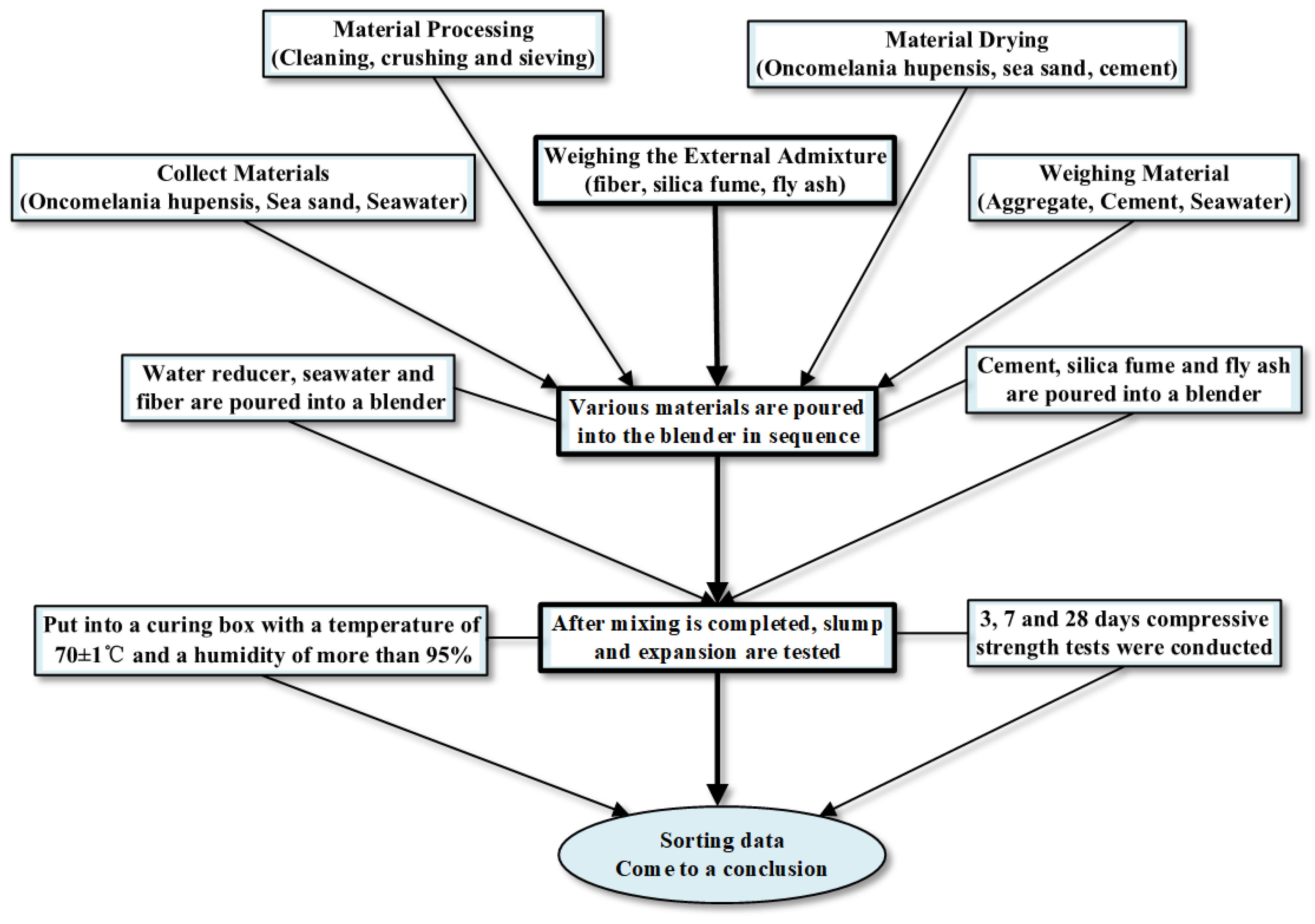
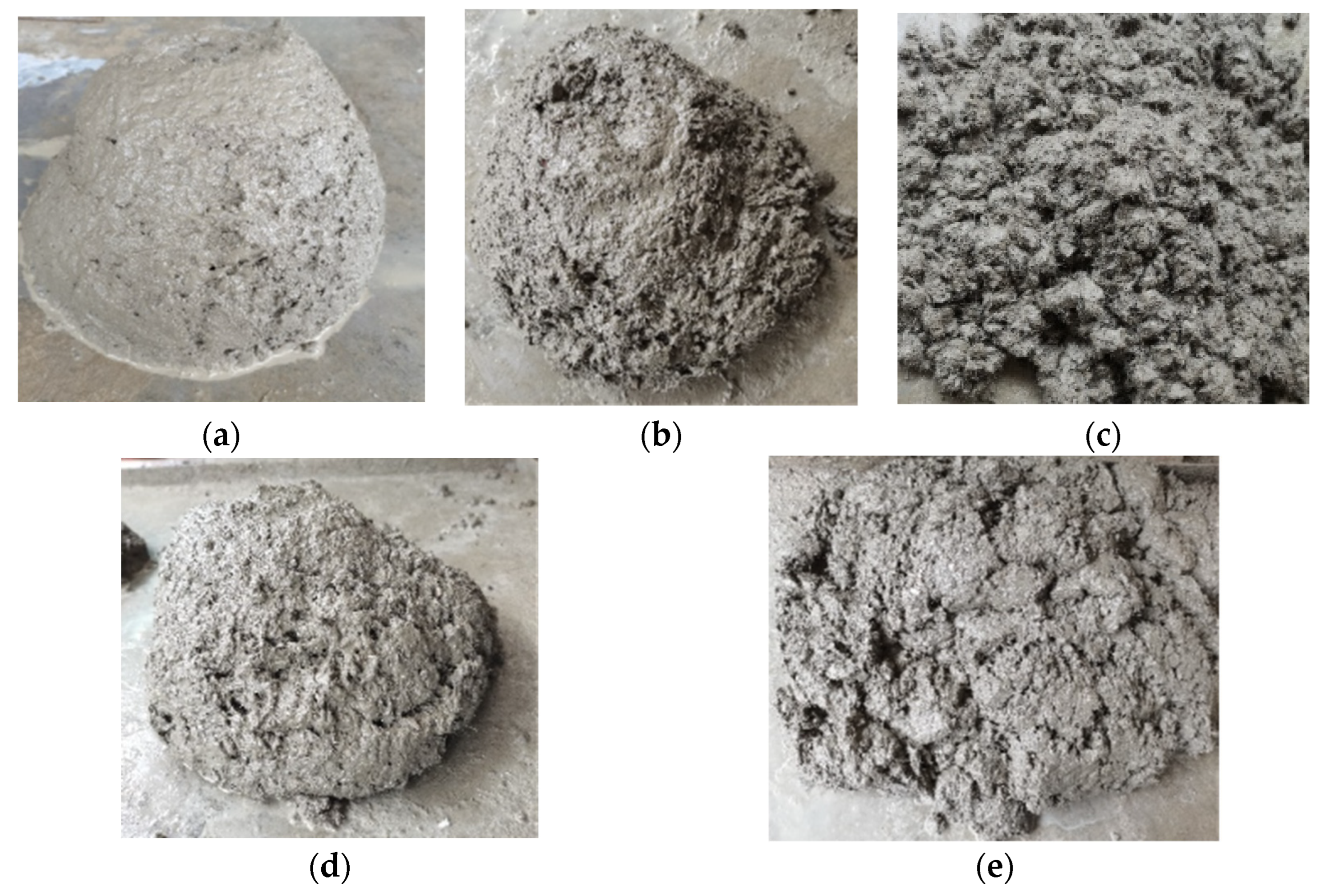
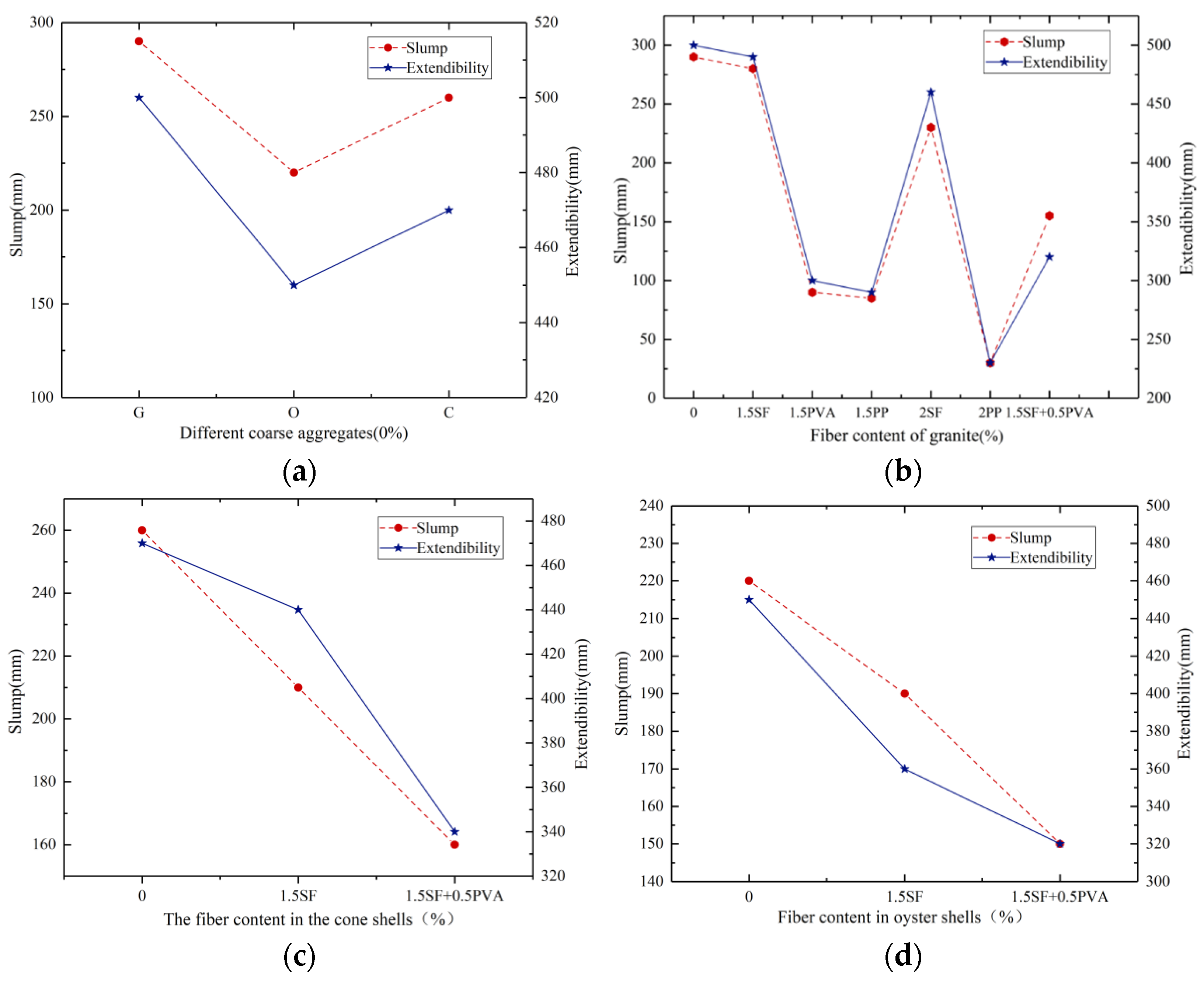
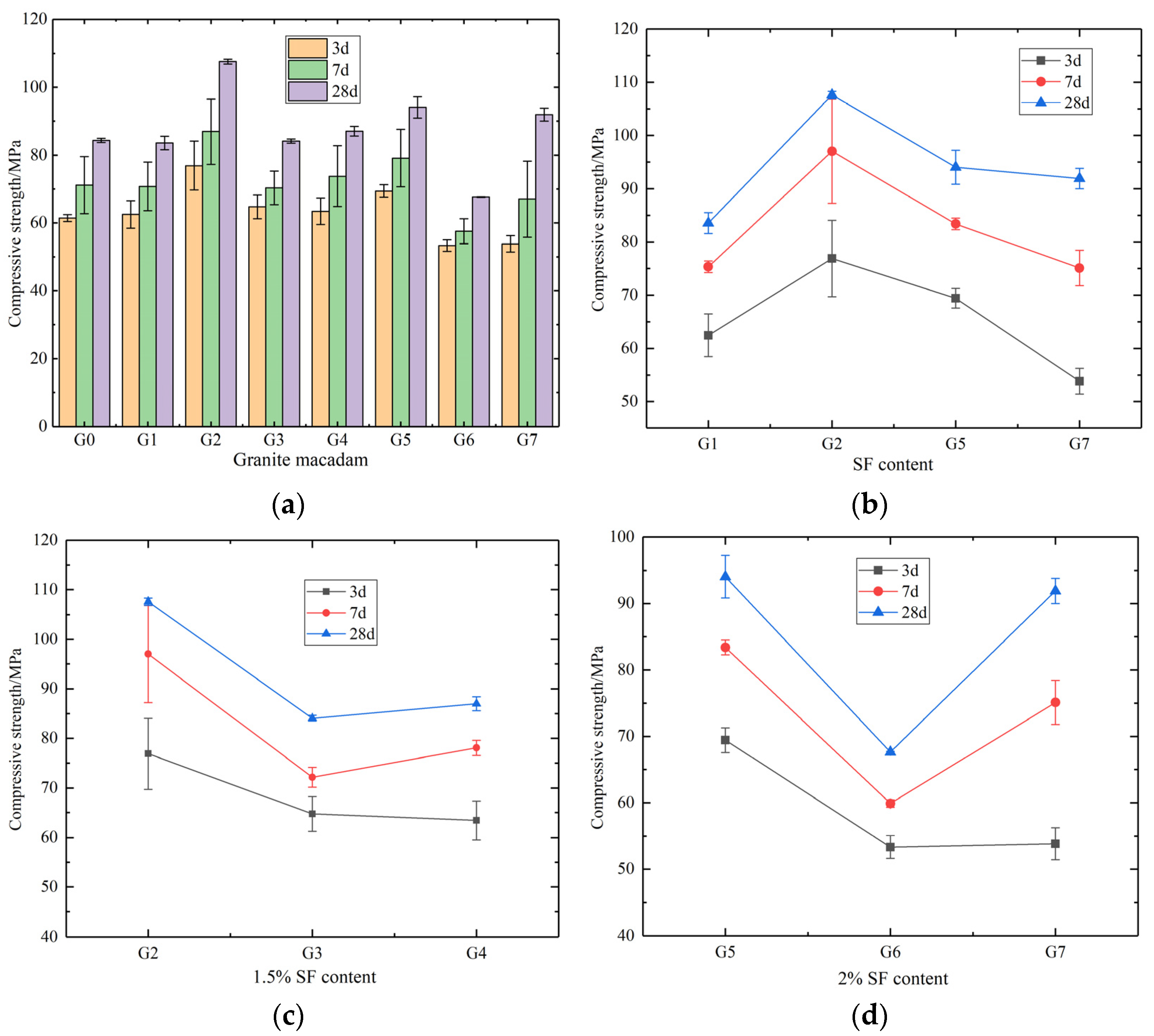
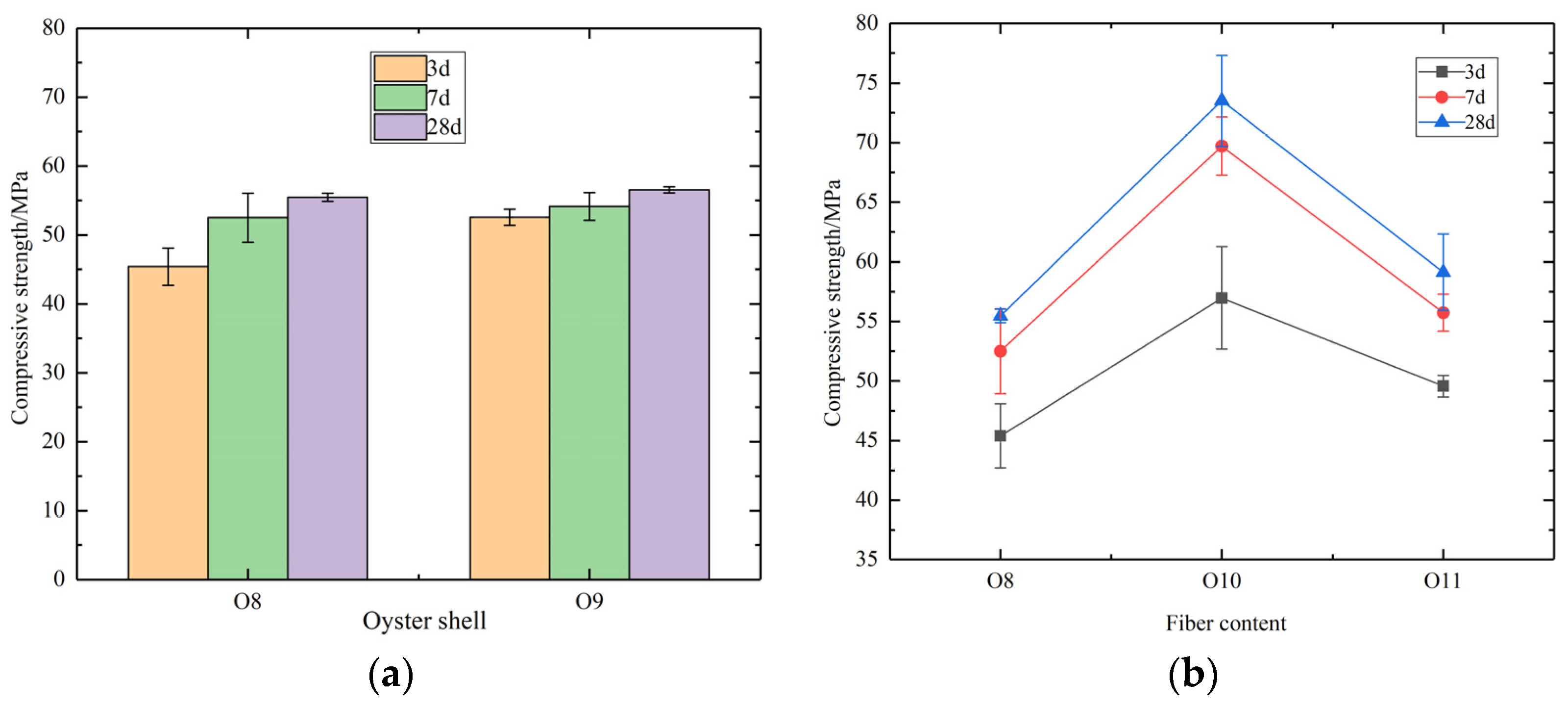

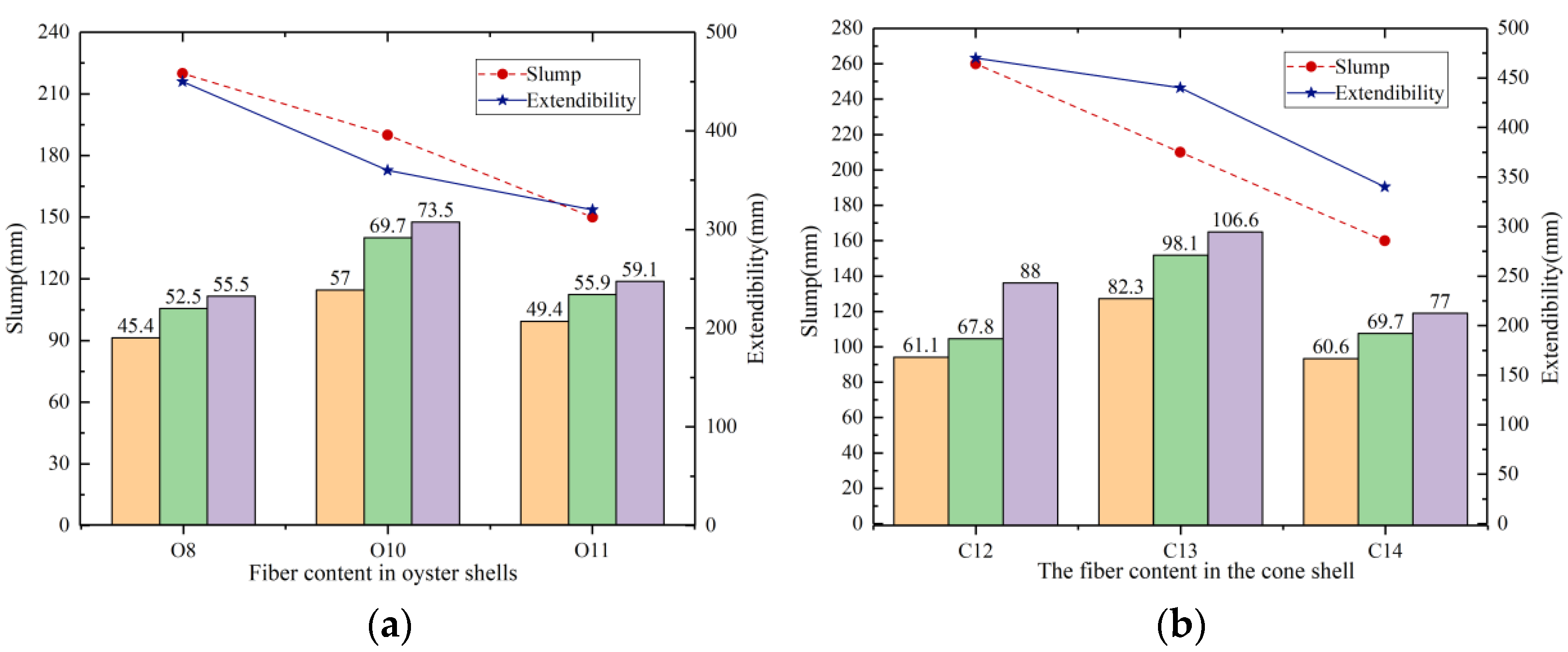
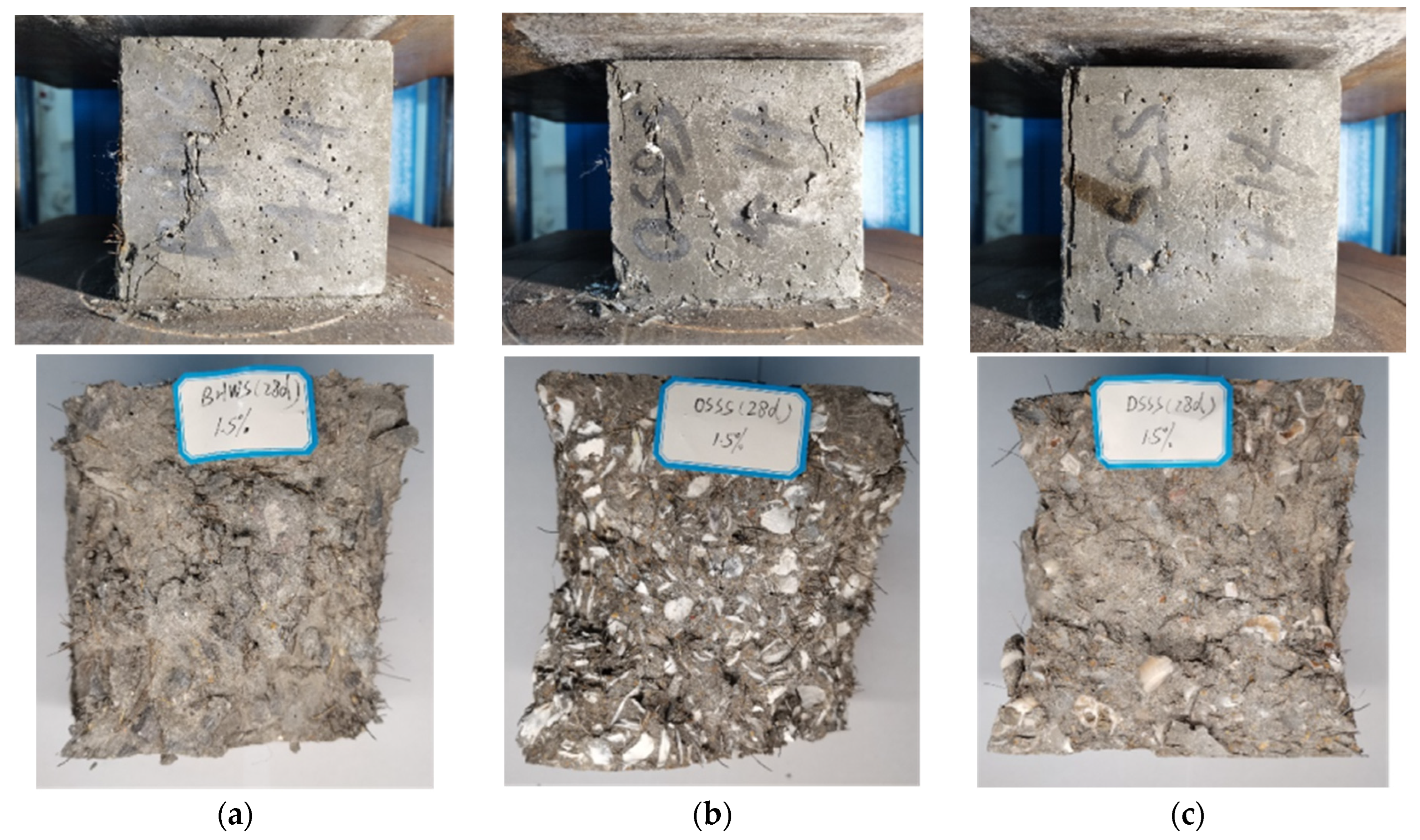
| Category | Particle Size (mm) | Apparent Density (kg/m3) | Bulk Density (kg/m3) | Porosity (%) | Mud Content (%) | Water Content (%) |
|---|---|---|---|---|---|---|
| Granite | 4.75–9.50 | 2671 | 1425 | 46.45 | 1.52 | 1.24 |
| Oyster shells | 4.75–9.50 | 2357.6 | 942.1 | 60.00 | 0.17 | 12.13 |
| Cone shells | 4.75–9.50 | 2765 | 1223 | 55.77 | 0.13 | 2.56 |
| Category | Particle Size (mm) | Apparent Density (kg/m3) | Bulk Density (kg/m3) | Porosity (%) | Mud Content (%) | Water Content (%) |
|---|---|---|---|---|---|---|
| River Sand | 2.72 | 2647 | 1725 | 34.84 | 3.4 | 0.14 |
| Sea sand | 2.66 | 2667 | 1480 | 44.51 | 0.4 | 0.82 |
| Detection Component | Cl−/Mg/L | SO42−/Mg/L | Na+/Mg/L | Ca2+/Mg/L | Mg2+/Mg/L |
|---|---|---|---|---|---|
| Testing result | 2.06 × 104 | 2.08 × 103 | 1.38 × 104 | 330 | 1.33 × 103 |
| Specific Surface Area (m2/kg) | Loss on Ignition (%) | Setting Time (min) | Stability | Compressive Strength (MPa) | Bending Strength (MPa) | |||
|---|---|---|---|---|---|---|---|---|
| Initial Setting | Final Setting | 3d | 28d | 3d | 28d | |||
| ≥300 | ≤3.5 | ≥45 | ≤390 | Qualified | 24.8 | 48.9 | 5.0 | 8.1 |
| Flyash | |||||||
|---|---|---|---|---|---|---|---|
| Loss on Ignition/% | Water Demand Ratio/% | Moisture/% | Dissociate CaO/% | Screen Allowance of 0.45 mm/% | SO3 Content/% | ||
| 3.2 | 91 | 0.3 | 0.6 | 7.6 | 1.6 | ||
| Silica Fume | |||||||
| SiO2/% | Fe2O3/% | refractoriness | CaO/% | MgO/% | NaO/% | TiO2/% | The passing rate of 200 mesh screens/% |
| 99.23 | 0.01 | 1760 °C | 0.01 | 0.01 | 0.05 | 0.03 | 95.2 |
| Number | Inspection Item | Unit | Standard Requirements | Test Result | Individual Evaluation | |
|---|---|---|---|---|---|---|
| 1 | Water reduction rate | % | ≥25 | 27 | qualified | |
| 2 | Bleeding rate ratio | % | ≤60 | 30 | qualified | |
| 3 | Gas content | % | ≤6.0 | 3.4 | qualified | |
| 4 | The difference in coagulation time | Initial setting | min | −90~+120 | +28 | qualified |
| Final setting | min | −90~+120 | +34 | qualified | ||
| 5 | Time variation (slump) of 1 h | mm | ≤80 | 40 | qualified | |
| 6 | Compressive strength ratio | 1 d | % | ≥170 | 178 | qualified |
| 3 d | % | ≥160 | 167 | qualified | ||
| 7 d | % | ≥150 | 156 | qualified | ||
| 28 d | % | ≥140 | 147 | qualified | ||
| 7 | Shrinkage ratio | % | ≤110 | 98 | qualified | |
| Fiber Type | Diameter (mm) | Length (mm) | Density (kg/m3) | Modulus of Elasticity (GPa) | Fracture Strength (MPa) | Tensile Elongation (%) |
|---|---|---|---|---|---|---|
| SF | 0.2 | 12 | 7800 | 200 | 1130 | 1.8 |
| PVA | 0.02 | 12 | 970 | 85 | 3000 | 6.0 |
| PP | 0.02 | 12 | 920 | 110 | 3000 | 8.7 |
| Number | Coarse Aggregate | Fine Aggregate | Cement | Silica Fume | Flyash | Water | Water-Reducing | Fibre |
|---|---|---|---|---|---|---|---|---|
| 1 | 500 (S) | 1006 (W) | 660 | 83 | 83 | 132 (W) | 43 | SF |
| 2 | 500 (S) | 1006 (W) | 660 | 83 | 83 | 132 (W) | 43 | PVA |
| 3 | 500 (S) | 1006 (W) | 660 | 83 | 83 | 132 (W) | 43 | PP |
| 4 | 500 (S) | 1006 (S) | 660 | 83 | 83 | 132 (S) | 43 | SF |
| 5 | 500 (O) | 1006 (S) | 660 | 83 | 83 | 132 (S) | 43 | SF |
| 6 | 500 (C) | 1006 (S) | 660 | 83 | 83 | 132 (S) | 43 | SF |
| Number | Coarse Aggregate | Fine Aggregate | Mixing Water | Fibre |
|---|---|---|---|---|
| 0 | Stone | Sea sand | Sea water | 0% |
| 1 | Stone | River sand | Freshwater | 0% |
| 2 | Stone | River sand | Freshwater | 1.5% SF |
| 3 | Stone | River sand | Freshwater | 1.5% PVA |
| 4 | Stone | River sand | Freshwater | 1.5% PP |
| 5 | Stone | River sand | Freshwater | 2% SF |
| 6 | Stone | River sand | Freshwater | 2% PP |
| 7 | Stone | River sand | Freshwater | 1.5% SF + 0.5 PVA |
| 8 | Oyster (I) | Sea sand | Sea water | 0% |
| 9 | Oyster (II) | Sea sand | Sea water | 0% |
| 10 | Oyster (I) | Sea sand | Sea water | 1.5% SF |
| 11 | Oyster (I) | Sea sand | Sea water | 1.5% SF + 0.5 PVA |
| 12 | Cone | Sea sand | Sea water | 0% |
| 13 | Cone | Sea sand | Sea water | 1.5% SF |
| 14 | Cone | Sea sand | Sea water | 1.5% SF + 0.5 PVA |
| Number | Coarse Aggregate | Fiber | Slump /mm | Expansion /mm |
|---|---|---|---|---|
| 0 | Gs | 0% | 285 | 490 |
| 1 | G | 0% | 290 | 500 |
| 2 | G | 1.5% SF | 280 | 490 |
| 3 | G | 1.5% PVA | 90 | 300 |
| 4 | G | 1.5% PP | 85 | 290 |
| 5 | G | 2% SF | 230 | 460 |
| 6 | G | 2% PP | 30 | 230 |
| 7 | G | 1.5% SF + 0.5 PVA | 155 | 320 |
| 8 | OI | 0% | 220 | 450 |
| 9 | OII | 0% | 215 | 440 |
| 10 | OI | 1.5% SF | 190 | 360 |
| 11 | OI | 1.5% SF + 0.5 PVA | 150 | 320 |
| 12 | C | 0% | 260 | 470 |
| 13 | C | 1.5% SF | 210 | 440 |
| 14 | C | 1.5% SF + 0.5 PVA | 160 | 340 |
| No | 3d | 7d | 28d | |||||||||
|---|---|---|---|---|---|---|---|---|---|---|---|---|
| F /kN | fcc/MPa | F /kN | fcc/MPa | F /kN | fcc/MPa | |||||||
| G0 | 650 | 656 | 635 | 61.4 | 804 | 798 | 785 | 75.6 | 880 | 892 | 891 | 84.3 |
| G1 | 706 | 634 | 633 | 62.5 | 780 | 797 | 802 | 75.3 | 878 | 901 | 860 | 83.6 |
| G2 | 728 | 878 | 822 | 76.9 | 924 | 1011 | 1129 | 97.1 | 1133 | 1140 | 1126 | 107.5 |
| G3 | 659 | 724 | 661 | 64.7 | 780 | 761 | 738 | 72.3 | 890 | 886 | 878 | 84.1 |
| G4 | 678 | 622 | 702 | 63.4 | 825 | 836 | 804 | 78.4 | 918 | 900 | 929 | 87.3 |
| G5 | 749 | 710 | 733 | 69.4 | 889 | 878 | 866 | 83.2 | 1028 | 966 | 975 | 94.0 |
| G6 | 575 | 541 | 568 | 53.3 | 624 | 632 | 636 | 59.9 | 713 | 711 | 713 | 67.7 |
| G7 | 569 | 540 | 591 | 54.2 | 756 | 791 | 825 | 75.1 | 991 | 957 | 955 | 91.9 |
| O8 | 463 | 510 | 460 | 45.4 | 517 | 592 | 549 | 52.5 | 579 | 582 | 590 | 55.5 |
| O9 | 567 | 544 | 548 | 52.8 | 592 | 549 | 568 | 54.6 | 590 | 600 | 596 | 56.9 |
| O0 | 652 | 578 | 569 | 57.0 | 738 | 757 | 706 | 69.7 | 820 | 750 | 750 | 73.5 |
| O11 | 533 | 518 | 515 | 49.4 | 568 | 592 | 600 | 55.9 | 584 | 636 | 647 | 59.1 |
| C12 | 649 | 639 | 657 | 61.1 | 764 | 670 | 706 | 67.8 | 903 | 952 | 924 | 88.0 |
| C13 | 824 | 922 | 850 | 82.3 | 997 | 1015 | 1087 | 98.1 | 1146 | 1099 | 1121 | 106.6 |
| C14 | 477 | 533 | 549 | 60.6 | 725 | 765 | 712 | 69.7 | 817 | 789 | 816 | 77 |
Disclaimer/Publisher’s Note: The statements, opinions and data contained in all publications are solely those of the individual author(s) and contributor(s) and not of MDPI and/or the editor(s). MDPI and/or the editor(s) disclaim responsibility for any injury to people or property resulting from any ideas, methods, instructions or products referred to in the content. |
© 2023 by the authors. Licensee MDPI, Basel, Switzerland. This article is an open access article distributed under the terms and conditions of the Creative Commons Attribution (CC BY) license (https://creativecommons.org/licenses/by/4.0/).
Share and Cite
Wang, S.; Zhang, M.; Shi, Y.; Chen, L.; Zhou, Y. A Preliminary Study Was Conducted on the Compressive Strength and Flow Performance of Environmentally Friendly UHPC-SCA. Buildings 2023, 13, 2226. https://doi.org/10.3390/buildings13092226
Wang S, Zhang M, Shi Y, Chen L, Zhou Y. A Preliminary Study Was Conducted on the Compressive Strength and Flow Performance of Environmentally Friendly UHPC-SCA. Buildings. 2023; 13(9):2226. https://doi.org/10.3390/buildings13092226
Chicago/Turabian StyleWang, Shuwei, Min Zhang, Yaoyang Shi, Lixin Chen, and Yingming Zhou. 2023. "A Preliminary Study Was Conducted on the Compressive Strength and Flow Performance of Environmentally Friendly UHPC-SCA" Buildings 13, no. 9: 2226. https://doi.org/10.3390/buildings13092226
APA StyleWang, S., Zhang, M., Shi, Y., Chen, L., & Zhou, Y. (2023). A Preliminary Study Was Conducted on the Compressive Strength and Flow Performance of Environmentally Friendly UHPC-SCA. Buildings, 13(9), 2226. https://doi.org/10.3390/buildings13092226








